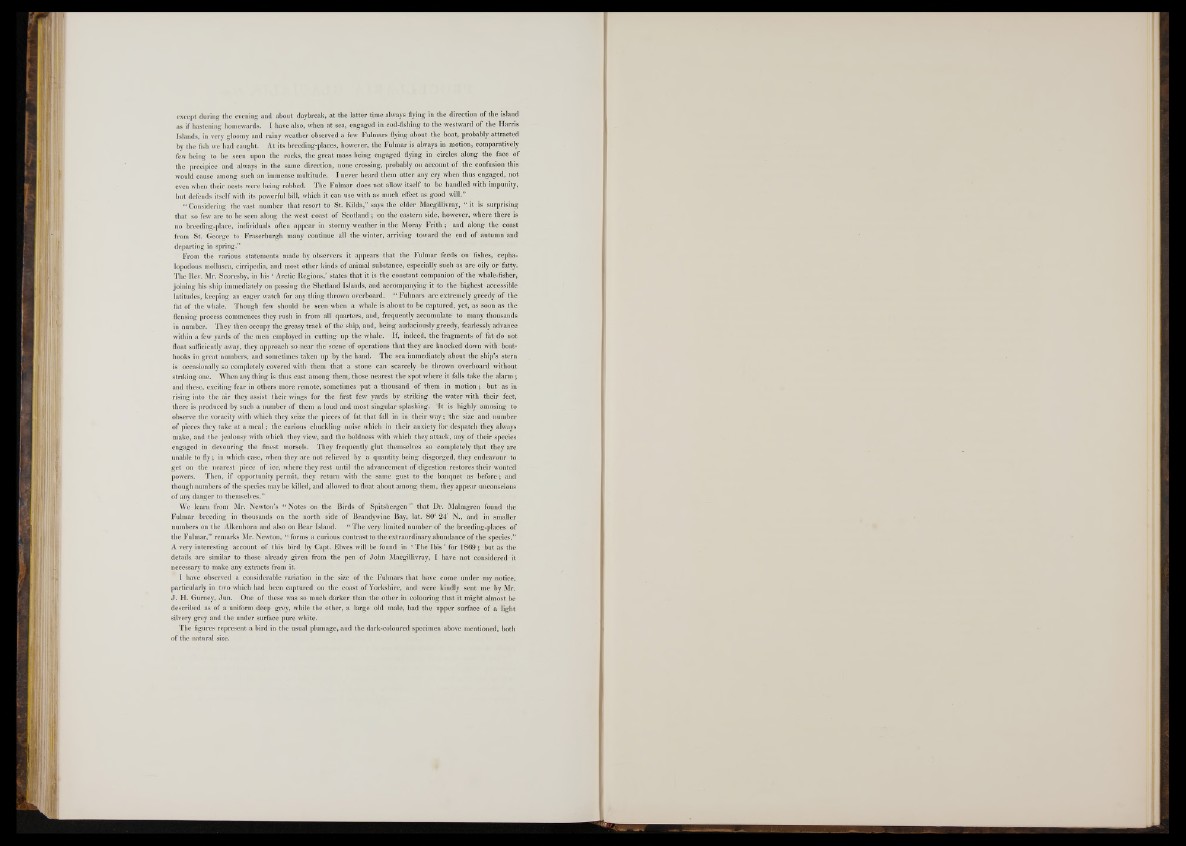
except during the evening and about daybreak, at the latter time always flying in the direction of the island
as if hastening homewards. I have also, when at sea, engaged in cod-fishing to the westward o f the Harris
Islands, in very gloomy and rainy weather observed a few Fulmars flying about the boat, probably attracted
by the fish we had caught. At its breeding-places, however, the Fulmar is always in motion, comparatively
few being to be seen upon the rocks, the great mass being engaged flying in circles along the face of
the precipice and always in the same direction, none crossing, probably on account o f the confusion this
would cause among such an immense multitude. I never heard them utter any cry when thus engaged, not
even when their nests were being robbed. The Fulmar does not allow itself to be handled with impunity,
but defends itself with its powerful bill, which it can use with as much effect as good will.”
“ Considering the vast number that resort to St. Kilda,” says the elder Macgillivray, “ it is surprising
that so few are to be seen along the west coast of Scotland ; on the eastern side, however, where there is
no breeding-place, individuals often appear in stormy weather in the Moray Frith ; and along the coast
from St. George to Fraserburgh many continue all the winter, arriving toward the end of autumn and
departing in spring.”
From the various statements made by observers it appears that the Fulmar feeds on fishes, cepha-
lopodous mollusca, cirripedia, and most other kinds o f animal substance, especially such as are oily or fatty.
The Rev. Mr. Scoresby, in his ‘ Arctic Regions,’ states that it is the constant companion o f the whale-fisher,
joining his ship immediately on passing the Shetland Islands, and accompanying it to the highest accessible
latitudes, keeping an eager watch for any thing thrown overboard. “ Fulmars are extremely greedy o f the
fat o f the whale. Though few should be seen when a whale is about to be captured, yet, as soon as the
flensing process commences they rush in from all quarters, and, frequently accumulate to many thousands
in number. They then occupy the greasy track of the ship, and, being audaciously greedy, fearlessly advance
within a few yards o f the men employed in cutting Up the whale. If, indeed, the fragments, o f fat do not
float sufficiently away, they approach so near the scene o f operations that they are knocked down with boat-
hooks in great numbers, and sometimes taken up by the hand. The sea immediately about the ship’s stern
is occasionally so completely covered with them that a stone can scarcely be thrown overboard without
striking one. When any thing is thus cast among them, those nearest the spot where it falls take the alarm ;
and these, exciting fear in others more remote, sometimes put a thousand o f them in motion ; but as in
rising into the air they assist their wings for the first few yards by striking the water with their feet,
there is produced by such a number of them a loud and most singular splashing, f t is highly amusing to
observe the voracity with which they seize the pieces of fat that fall in in their way; the size and number
of pieces they take at a meal; the curious chuckling noise which in their anxiety for despatch they always
make, and the jealousy with which they view, and the boldness with which they attack, any o f their species
engaged in devouring the finest morsels. They frequently glut themselves so completely that they are
unable to fly; in which case, when they are not relieved by a quantity being disgorged, they endeavour to
get on the nearest piece o f ice, where they rest until the advancement o f digestion restores their wonted
powers. Then, if opportunity permit, they return with the same gust to the banquet as before; and
though numbers of the species may be killed, and allowed to float about among them, they appear unconscious
of any danger to themselves.”
We learn from Mr. Newton’s “ Notes on the Birds of Spitsbergen ” that Dr. Malmgren found the
Fulmar breeding in thousands on the north side of Brandywine Bay, lat. 80° 24' N., and in smaller
numbers on the Alkenhorn and also on Bear Island. “ The very limited number o f the breeding-places of
the Fulmar,” remarks Mr. Newton, “ forms a curious contrast to the extraordinary abundance o f the species.”
A very interesting account of this bird by Capt. Elwes will be found in ‘ The Ibis ’ for 1869; but as the
details are similar to those already given from the pen of John Macgillivray, I have not considered it
necessary to make any extracts from it.
I have observed a considerable variation in the size of the Fulmars that have come under my notice,
particularly in two which had been captured on the coast o f Yorkshire, and were kindly sent me by Mr.
J. H. Gurney, Jun. One of these was so much darker than the other in colouring that it might almost be
described as of a uniform deep grey, while the other, a large old male, had the upper surface of a light
silvery grey and the under surface pure white.
The figures represent a bird in the usual plumage, and the dark-coloured specimen above mentioned, both
of the natural size.